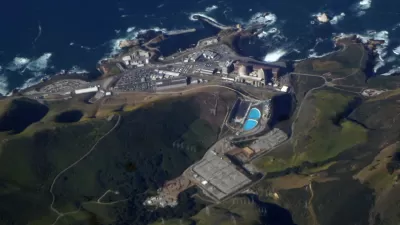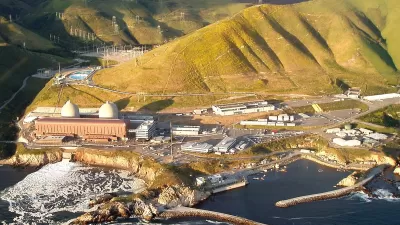A bipartisan bill, fiercely opposed by many in the environmental community, would keep the Diablo Canyon Power Plant operating beyond 2025. The bill received overwhelming approval after it was amended to shorten the duration of the extension.

It appears that the Diablo Canyon Power Plant may be spared the recent fate of Michigan's Palisades Power Plant thanks to a critical midnight vote by the California Legislature on the last day of the legislative session.
As a result, Pacific Gas & Electric (PG&E), the owner and operator of the 37-year-old nuclear power plant, the state's largest, supplying "17% of California’s zero-carbon electricity and more than 8% of its total electricity," according to Sen. Bill Dodd (D-Napa), has applied for funding from the U.S. Department of Energy's Civil Nuclear Credit Program, a new $6 billion program established by the Infrastructure Investment and Jobs Act.
Critical Legislation Approved
"State lawmakers approved SB 846, which would keep the plant open for five more years, until 2030, and give its operator, Pacific Gas & Electric, a $1.4 billion loan to do so," reported Nadia Lopez on Sept. 1 for CalMatters, a non-profit news organization focused on California issues.
The measure, authored by Republican Assemblymember Jordan Cunningham of San Luis Obispo and Democratic state Sen. Bill Dodd of Napa, gained overwhelming support in the Assembly in a 67-3 vote during the debate, which continued into the early hours of this morning.
The bill mirrors draft legislation Gov. Gavin Newsom proposed on Aug. 12, with a few key differences: Newsom wanted to extend the life of the plant for ten years, which received widespread opposition from legislators. The bill also includes stronger protections for ratepayers, and the loan would be allocated in increments. Lawmakers will have to approve spending of state funds in excess of $600 million.
Environmental Opposition
“Gov. Newsom’s effort to keep Diablo Canyon open contradicts a 2016 agreement environmental and labor groups reached with PG&E to begin shutting down the 37-year-old power plant starting in 2024," said Brandon Dawson, Director of Sierra Club California, in a July 7 press release.
Sierra Club activists were leaders in the initial effort to stop the construction of Diablo Canyon, and we continue to oppose its dangerous and environmentally harmful operation today.
Governor's Signing Message
Gov. Newsom wasted no time in signing the bill on Sept. 2. "Climate change is causing unprecedented stress on California's energy system and I appreciate the Legislature's action to maintain energy reliability as the State accelerates the transition to clean energy," stated Newsom [pdf].
Senate Bill 846 facilitates the actions necessary to keep the option of the Diablo Canyon Power Plant as a statewide reliability asset beyond the current 2024-2025 retirement dates of the plant's two units.
Next Steps
"PG&E must now obtain the necessary U.S. Nuclear Regulatory Commission (NRC) licenses, as well as other required state regulatory approvals," states their press release after Gov. Newsom signed the bill.
The law directs all relevant state agencies and PG&E as the plant operator to act quickly and coordinate on the necessary and prudent actions to extend plant operations.
The release indicates that PG&E has applied for funding from the Civil Nuclear Credit Program, the deadline having been extended to Sept. 6 as a result of requests made by Gov. Newsom in a letter sent in May asking for changes to to the program to allow for the PG&E to qualify for the program.
The bill directs PG&E to take steps to secure funds from the U.S Department of Energy (DOE), and any other potentially available federal funding, which would be used to pay back the [$1.4 billion] loan and lower costs for customers.
Money-Back Provision
Reporting on Sept. 2 on the passage and signing of the legislation and PG&E's next steps, AP political writer Michael R. Blood indicates that that the state could back out of the deal if the Energy Department rejects PG&E's application for the nuclear credit program.
Heat Wave!
"The bill’s passage comes amid an intense heat wave, which prompted Newsom Wednesday to proclaim a state of emergency," adds Lopez of CalMatters in the source article. "The California Independent System Operator, which manages the state’s power grid, supported Newsom’s plea for the Diablo Canyon extension. "
“California has relied on the Diablo Canyon Power Plant for decades. This supply provides significant support for the grid during evening hours when solar is no longer operating,” said Elliot Mainzer, the grid operator’s president and CEO. “We should ensure new sources of clean electric supply are in place before retiring non-emitting generation that plays such an instrumental role supporting reliable electric service.”
The emergency proclamation enables the state to relax climate and air pollution regulations to increase electricity production to avoid power outages.
Bye-Bye Palisades
The governor's intervention and state legislation that encouraged PG&E to apply for federal funds to extend the life of their plant that had been slated to close in 2025 comes as a direct result of the passage of the Infrastructure Investment and Jobs Act last November as a post in May noted.
The [Civil Nuclear Credit] program “aims to give a financial lifeline to plants facing imminent shutdown for economic reasons,” writes Evan Halper for The Washington Post (source article) on April 19.
The first round of credits are set aside for plants that have already announced plans to close. There are at least two such operations in the United States: Diablo Canyon in California and Palisades in [Covert] Michigan.
Alas, the program came too late for the Palisades Power Plant, which was shut down a month after the Post published Halper's piece on the new infrastructure program administered by the Department of Energy, as indicated by June 28 press release from the plant's New Orleans-based owner and operator.
Entergy today completed the sale of the subsidiary that owns the Palisades Power Plant to Holtec International to ensure a safe and timely decommissioning of the nuclear site. Palisades was permanently shut down May 20, 2022, after generating safe, secure and reliable electricity for more than 50 years.
[See related posts on another nuclear power plant shutdown in New York "by April 2021" and the difficulties in decommissioning another California nuclear power plant in 2014.]
Additional posts (to the three show below the post) on the Diablo Canyon Power Plant:
FULL STORY: Diablo Canyon: Nuke plant a step closer to staying open longer

Planetizen Federal Action Tracker
A weekly monitor of how Trump’s orders and actions are impacting planners and planning in America.

Maui's Vacation Rental Debate Turns Ugly
Verbal attacks, misinformation campaigns and fistfights plague a high-stakes debate to convert thousands of vacation rentals into long-term housing.

San Francisco Suspends Traffic Calming Amidst Record Deaths
Citing “a challenging fiscal landscape,” the city will cease the program on the heels of 42 traffic deaths, including 24 pedestrians.

Amtrak Rolls Out New Orleans to Alabama “Mardi Gras” Train
The new service will operate morning and evening departures between Mobile and New Orleans.

The Subversive Car-Free Guide to Trump's Great American Road Trip
Car-free ways to access Chicagoland’s best tourist attractions.

San Antonio and Austin are Fusing Into one Massive Megaregion
The region spanning the two central Texas cities is growing fast, posing challenges for local infrastructure and water supplies.
Urban Design for Planners 1: Software Tools
This six-course series explores essential urban design concepts using open source software and equips planners with the tools they need to participate fully in the urban design process.
Planning for Universal Design
Learn the tools for implementing Universal Design in planning regulations.
Heyer Gruel & Associates PA
JM Goldson LLC
Custer County Colorado
City of Camden Redevelopment Agency
City of Astoria
Transportation Research & Education Center (TREC) at Portland State University
Jefferson Parish Government
Camden Redevelopment Agency
City of Claremont





























